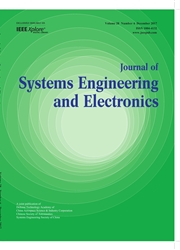

 中文摘要:
中文摘要:
The problem of angle estimation for bistatic multipleinput multiple-output radar in the present of unknown mutual coupling (MC) is investigated, and a three-way compressive sensing (TWCS) estimation algorithm is developed. To exploit the inherent multi-dimensional structure of received data, a trilinear tensor model is firstly formulated. Then the de-coupling operation is followed. Thereafter, the high-order singular value decomposition is applied to compress the high dimensional tensor to a much smaller one. The estimation of the compressed direction matrices are linked to the compressed trilinear model, and finally two overcomplete dictionaries are constructed for angle estimation. Also,Cramer-Rao bounds for angle and MC estimation are derived. The proposed TWCS algorithm is effective from the perspective of estimation accuracy as well as the computational complexity, and it can achieve automatically paired angle estimation. Simulation results show that the proposed method has much better estimation accuracy than the existing algorithms in the low signal-to-noise ratio scenario, and its estimation performance is very close to the parallel factor analysis (PARAFAC) algorithm at the high SNR regions.
 英文摘要:
英文摘要:
The problem of angle estimation for bistatic multiple-input multiple-output radar in the present of unknown mutual coupling (MC) is investigated, and a three-way compressive sensing (TWCS) estimation algorithm is developed. To exploit the inherent multi-dimensional structure of received data, a trilinear tensor model is firstly formulated. Then the de-coupling operation is followed. Thereafter, the high-order singular value decomposition is applied to compress the high dimensional tensor to a much smaller one. The estimation of the compressed direction matrices are linked to the compressed trilinear model, and finally two over-complete dictionaries are constructed for angle estimation. Also, Cramer-Rao bounds for angle and MC estimation are derived. The proposed TWCS algorithm is effective from the perspective of estimation accuracy as well as the computational complexity, and it can achieve automatically paired angle estimation. Simulation results show that the proposed method has much better estimation accuracy than the existing algorithms in the low signal-to-noise ratio scenario, and its estimation performance is very close to the parallel factor analysis (PARAFAC) algorithm at the high SNR regions. ? 2017 Beijing Institute of Aerospace Information.
 同期刊论文项目
同期刊论文项目
 同项目期刊论文
同项目期刊论文
 pattern synthesis for opportunistic array radar using least square fitness estimation-genetic algori
pattern synthesis for opportunistic array radar using least square fitness estimation-genetic algori Noncircular-PARAFAC for 2D-DOA estimation of noncircular signals in arbitrarily spaced acoustic vect
Noncircular-PARAFAC for 2D-DOA estimation of noncircular signals in arbitrarily spaced acoustic vect 期刊信息
期刊信息
